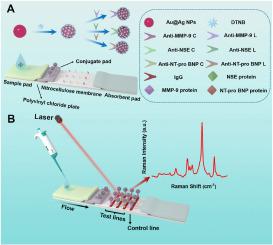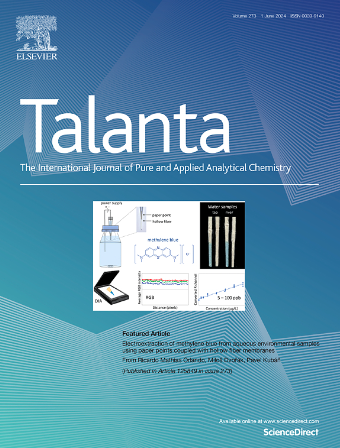A colorimetric and SERS-based LFIA for sensitive and simultaneous detection of three stroke biomarkers: An ultra-fast and sensitive point-of-care testing platform
IF 5.6
1区 化学
Q1 CHEMISTRY, ANALYTICAL
引用次数: 0
Abstract
Stroke ranks as the second leading cause of disability and mortality globally. Biomarker detection represents a promising avenue for predicting disease severity and prognosis. The expression levels of metalloproteinase-9 (MMP-9), neuron-specific enolase (NSE), and N-terminal pro-brain natriuretic peptide (NT-pro BNP) in blood correlate with stroke severity. Hence, monitoring these biomarkers is crucial for stroke diagnosis and management. Point-of-care testing (POCT) offers on-site diagnostic capabilities, with lateral flow immunoassay (LFIA) being the most widely used method currently. However, traditional LFIA sensitivity requires enhancement. This study introduces an ultra-sensitive surface-enhanced Raman scattering-based lateral flow immunoassay (SERS-based LFIA) strip for simultaneous detection of the three stroke biomarkers using SERS immune tags. Bimetallic core-shell structured SERS immune tags leverage the advantages of two metals, ensuring stability and enhancing Raman signals through plasmon resonance. This development of a POCT based on SERS-based LFIA strips offers rapid, sensitive, and multiplex detection of stroke biomarkers. The limits of detection (LODs) for MMP-9, NSE, and NT-pro BNP were 0.00020 ng mL−1, 0.00016 ng mL−1, and 0.00012 ng mL−1, respectively. Furthermore, enzyme-linked immunosorbent assay (ELISA) validated the accuracy of SERS-based LFIA. Clinical sample analysis demonstrated consistency between outcomes obtained by SERS-based LFIA and ELISA. Thus, SERS-based LFIA presents a novel POCT approach for stroke diagnosis.

基于比色法和 SERS 的 LFIA,可同时灵敏检测三种中风生物标记物:超快速、灵敏的护理点检测平台
中风是全球第二大致残和致死原因。生物标志物检测是预测疾病严重程度和预后的一个有前途的途径。血液中金属蛋白酶-9 (MMP-9)、神经元特异性烯醇化酶 (NSE) 和 N 端脑钠肽 (NT-pro BNP) 的表达水平与中风的严重程度相关。因此,监测这些生物标志物对中风的诊断和管理至关重要。床旁检测(POCT)提供了现场诊断能力,其中侧流免疫分析(LFIA)是目前应用最广泛的方法。然而,传统的侧流免疫分析法灵敏度有待提高。本研究介绍了一种超灵敏的基于表面增强拉曼散射的侧流免疫分析(SERS-based LFIA)条,利用 SERS 免疫标记同时检测三种中风生物标记物。双金属核壳结构的 SERS 免疫标记利用了两种金属的优势,确保了稳定性,并通过等离子体共振增强了拉曼信号。这种基于 SERS 的 LFIA 试剂条开发的 POCT 能快速、灵敏、多重地检测中风生物标记物。MMP-9、NSE和NT-pro BNP的检测限(LOD)分别为0.00020 ng mL-1、0.00016 ng mL-1和0.00012 ng mL-1。此外,酶联免疫吸附试验(ELISA)验证了基于 SERS 的 LFIA 的准确性。临床样本分析表明,基于 SERS 的 LFIA 和 ELISA 得出的结果是一致的。因此,基于 SERS 的 LFIA 为中风诊断提供了一种新型的 POCT 方法。
本文章由计算机程序翻译,如有差异,请以英文原文为准。
求助全文
约1分钟内获得全文
求助全文
来源期刊

Talanta
化学-分析化学
CiteScore
12.30
自引率
4.90%
发文量
861
审稿时长
29 days
期刊介绍:
Talanta provides a forum for the publication of original research papers, short communications, and critical reviews in all branches of pure and applied analytical chemistry. Papers are evaluated based on established guidelines, including the fundamental nature of the study, scientific novelty, substantial improvement or advantage over existing technology or methods, and demonstrated analytical applicability. Original research papers on fundamental studies, and on novel sensor and instrumentation developments, are encouraged. Novel or improved applications in areas such as clinical and biological chemistry, environmental analysis, geochemistry, materials science and engineering, and analytical platforms for omics development are welcome.
Analytical performance of methods should be determined, including interference and matrix effects, and methods should be validated by comparison with a standard method, or analysis of a certified reference material. Simple spiking recoveries may not be sufficient. The developed method should especially comprise information on selectivity, sensitivity, detection limits, accuracy, and reliability. However, applying official validation or robustness studies to a routine method or technique does not necessarily constitute novelty. Proper statistical treatment of the data should be provided. Relevant literature should be cited, including related publications by the authors, and authors should discuss how their proposed methodology compares with previously reported methods.
 求助内容:
求助内容: 应助结果提醒方式:
应助结果提醒方式:


